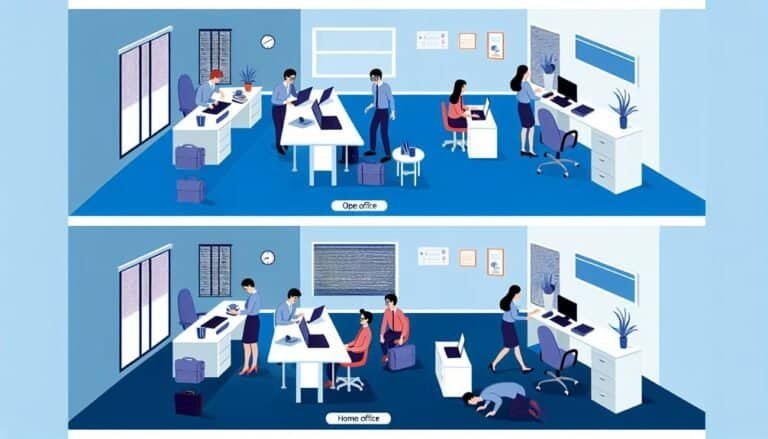Remote Work Tools and Technologies: What’s New in 2024?
Welcome to the future of remote work! The year 2024 is bringing exciting advancements in remote work tools and technologies that will revolutionize how you work from anywhere. Whether you are a remote worker, a team leader, or a business owner, staying up-to-date with the latest tools and technologies is essential to thrive in the remote work landscape.
In this article, we will explore the cutting-edge remote work software, virtual collaboration tools, video conferencing platforms, productivity apps, project management tools, remote team communication solutions, time tracking software, remote access solutions, and remote work equipment that are shaping the way we work remotely.
Key Takeaways:
- Remote work is evolving rapidly, with new tools and technologies transforming the way we work.
- The year 2024 brings advancements in remote work software, virtual collaboration tools, and video conferencing platforms.
- Productivity apps and project management tools optimize remote team communication and enhance productivity.
- Time tracking software and remote access solutions ensure efficient remote work processes.
- Investing in remote work equipment is crucial for creating a comfortable and productive remote work environment.
The Changing Landscape of Remote Work
Remote work has come a long way from its early beginnings. The traditional office model, once the cornerstone of work life, has been challenged and reshaped by advances in technology, changing employee preferences, and the lessons learned during the COVID-19 pandemic.
With the advent of technology, the workplace landscape has undergone a dramatic transformation. The traditional 9-to-5 office setup is no longer the only option for productive work. Remote work has emerged as a flexible alternative, allowing employees to work from anywhere, whether it’s their home, a coffee shop, or even a beach.
The COVID-19 pandemic has accelerated the adoption of remote work globally. Organizations were forced to quickly adapt to new ways of working to ensure business continuity. As a result, remote work became the norm, highlighting its viability and benefits.
Remote work has proven that physical proximity is not a prerequisite for collaboration and productivity. Advances in technology have facilitated seamless communication and virtual collaboration, bridging the gap between remote team members.
Employee preferences have also played a significant role in shaping the changing landscape of remote work. Many employees now value the flexibility and freedom that remote work offers. They appreciate the ability to tailor their work environment to suit their individual needs, resulting in increased job satisfaction and work-life balance.
Furthermore, the traditional office model has lost some of its appeal due to the daily commute, rigid schedules, and the limitations of a physical workspace. Employees are embracing the autonomy that remote work provides, allowing them to design their workday and environment to optimize their productivity.
Advances in technology have been instrumental in supporting remote work’s growth and success:
- Virtual collaboration tools have enabled real-time communication and seamless teamwork, surpassing the limitations of traditional office-based interactions.
- Cloud-based project management platforms have allowed remote teams to collaborate on projects, track progress, and manage tasks efficiently.
- Advancements in video conferencing technology have made virtual meetings and conferences feel more immersive and personal, bridging the gap between remote colleagues and clients.
- Remote access solutions have provided secure and convenient access to company resources and data from any location, ensuring productivity and connectivity for remote workers.
The workplace landscape is evolving rapidly, and remote work is at the forefront of this transformation. As we look to the future, it’s clear that the traditional office model will continue to coexist with remote work, giving rise to a hybrid work environment where employees have the flexibility to choose how and where they work.
The Rise of Digital Nomadism
One of the most significant shifts in remote work is the rise of digital nomadism. Digital nomads are individuals who work remotely while traveling and living in various locations around the world. They leverage technology to maintain their careers while exploring new cultures and environments.
With the advent of advanced communication tools and the increasing accessibility of remote work, digital nomadism has gained momentum in recent years. This lifestyle offers unparalleled freedom and flexibility, allowing individuals to design their work-life balance according to their preferences.
The use of technology plays a central role in enabling digital nomadism. From virtual collaboration platforms and cloud-based project management tools to reliable internet connectivity, technology has removed the geographical barriers that once confined work to a physical office space.
The digital nomad lifestyle offers the opportunity to work while immersing oneself in different cultures, experiencing new landscapes, and connecting with people from diverse backgrounds. It allows individuals to break free from the constraints of traditional employment, creating a sense of adventure and exploration.
However, digital nomadism also comes with its own set of challenges. Remote work while traveling requires careful planning and time management to ensure productivity and meet deadlines. It demands adaptability and resilience, as nomads navigate unfamiliar environments and potential connectivity issues.
“Digital nomadism combines work and travel, enabling individuals to embrace the world as their office. It offers a unique blend of professional growth and personal fulfillment.”
Digital Nomadism in Numbers
The popularity of digital nomadism can be seen in the increasing number of individuals embracing this lifestyle. According to a survey conducted by MBO Partners, there were an estimated 10.9 million digital nomads in 2019. The same study projected that the number could rise to 13.4 million by 2024.
To get a better understanding of the digital nomad trend, let’s examine some key statistics:
| Year | Number of Digital Nomads (in millions) |
|---|---|
| 2015 | 4.8 |
| 2018 | 7.3 |
| 2021 | 11.0 |
| 2024 (projected) | 13.4 |
Note: These statistics are based on estimates and may vary depending on various factors such as economic conditions, technological advancements, and social trends.
The rise of digital nomadism signifies a shift in how people perceive work and the traditional office environment. It represents a desire for more autonomy and a longing for a lifestyle that prioritizes freedom, flexibility, and the pursuit of personal passions.
As digital nomadism gains traction, we can expect to see further advancements in technologies and services catered to this lifestyle, such as digital nomad communities, co-working spaces in popular travel destinations, and tailored insurance and financial solutions.
Embracing the digital nomad lifestyle requires a mindset open to change, adaptability, and a willingness to seize new opportunities. It offers a unique blend of work and adventure, where your office can be a beach in Bali one day and a café in Paris the next.
Virtual Office Spaces
As remote work continues to gain popularity, the demand for virtual office spaces has also increased. Virtual offices offer a solution for remote workers and businesses who require a professional address and administrative services without the need for a physical office presence.
With a virtual office, you can establish a professional address in multiple regions, enhancing your business reputation and credibility. This is particularly important for businesses operating in diverse geographic locations, as it allows you to project a local presence in each region.
Moreover, virtual office spaces provide administrative services such as mail handling, call forwarding, and receptionist support. This ensures that your business operations run smoothly, even if you are working remotely or have team members spread across different locations.
By utilizing virtual office spaces, you can enjoy the benefits of a physical presence without the costly overheads associated with renting or maintaining a traditional office. This cost-effective solution allows you to allocate your resources more efficiently and invest in other areas of your business.
“Virtual office spaces provide a flexible and convenient solution for businesses looking to maintain a professional image and administrative support, regardless of their physical location.”
Whether you are a freelancer, remote worker, or a small business owner, virtual office spaces offer the flexibility and convenience you need to thrive in the remote work landscape. They enable you to maintain a professional image and access critical administrative services, all while enjoying the benefits of remote work.
| Benefits of Virtual Office Spaces |
|---|
| Professional address in multiple regions |
| Administrative services (mail handling, call forwarding, receptionist support) |
| Cost-effective alternative to traditional office spaces |
| Flexibility to work remotely while maintaining a professional image |
| Access to resources and support for remote business operations |
With the increasing availability of virtual office spaces, you can establish and expand your business presence with ease. Embrace the flexibility and benefits of remote work while maintaining a professional image through virtual office solutions.
While creating your setup for a remote work lifestyle, considering ways to establish a credible business presence is crucial. An effective solution is getting a virtual address, which enhances professional image and provides flexibility for digital operations. This can seamlessly complement advancements in remote work tools and technologies by promoting a local business presence without the need for physical office space.
Advancements in Communication Tools
Remote collaboration has been made seamless and efficient through advancements in communication tools. Whether you are working with colleagues or managing a remote team, these tools facilitate real-time communication and project management, ensuring that you can work together as effectively as if you were in the same office.
Video Conferencing
Video conferencing platforms like Zoom, Microsoft Teams, and Google Meet have become essential for remote teams. Through video calls, you can connect with colleagues, clients, and stakeholders face-to-face, fostering a sense of connection and enabling effective communication. With features like screen sharing, breakout rooms, and chat functions, video conferencing tools offer a comprehensive solution for meetings, presentations, and group discussions.
Team Collaboration Platforms
Team collaboration platforms, such as Slack, Microsoft Teams, and Trello, provide a centralized hub for remote teams to collaborate and manage projects. These platforms offer features like channels, direct messaging, file sharing, task assignments, and progress tracking, ensuring that all team members are aligned and working towards common goals. They promote transparency, accountability, and efficient workflow, enabling teams to collaborate seamlessly from anywhere.
Project Management Software
Project management software, such as Asana, Basecamp, and Jira, streamlines remote project management and enhances team productivity. These tools allow you to plan and organize tasks, set deadlines, assign responsibilities, track progress, and maintain a clear overview of project timelines and deliverables. With features like Gantt charts, task dependencies, and customizable workflows, project management software empowers remote teams to work efficiently and stay organized.
With the help of these communication tools, remote collaboration has become easier and more effective than ever. Real-time communication and seamless project management enable remote teams to overcome geographical barriers and work together towards shared goals, bridging the gap between remote and in-office work environments.
Your Table Heading
| Communication Tool | Key Features | Benefits |
|---|---|---|
| Video Conferencing Platforms | Face-to-face communication, screen sharing, chat functions | – Enhanced collaboration – Improved communication – Efficient meetings |
| Team Collaboration Platforms | Channels, direct messaging, file sharing, task assignments | – Centralized collaboration – Transparency and accountability – Streamlined workflow |
| Project Management Software | Task planning, deadline setting, progress tracking, customizable workflows | – Organized project management – Clear overview of tasks and deadlines – Efficient task allocation |
This table highlights the key communication tools, their features, and the benefits they bring to remote teams. These tools play a crucial role in enabling effective communication, seamless collaboration, and streamlined project management, ensuring that remote teams can work together efficiently and achieve their goals.
Emphasis on Well-being
Organizations have recognized the importance of prioritizing the well-being of remote workers. With the boundaries between work and personal life becoming increasingly blurred, it is crucial to support employees’ physical and mental health. To address the unique challenges associated with remote work, companies are implementing various initiatives.
Work-Life Balance
Achieving work-life balance is a key aspect of promoting the well-being of remote workers. Companies are encouraging employees to establish clear boundaries between work and personal life, allowing them to maintain a healthy equilibrium. By setting flexible work hours, remote workers have the freedom to allocate time for personal commitments and self-care.
Well-being Programs
Well-being programs are being introduced to provide remote workers with resources and support for maintaining good physical and mental health. These programs encompass a range of activities such as virtual fitness classes, mindfulness sessions, and wellness challenges. By actively promoting well-being, organizations foster a positive work environment and encourage employees to prioritize self-care.
“Supporting the well-being of remote workers is not only a moral imperative but also a strategic business decision. When employees feel valued and supported, they are more productive and engaged.”
Mental Health Resources
Recognizing the impact of remote work on mental health, organizations are offering mental health resources to support their employees. This may include access to counseling services, mental health hotlines, and online resources. By providing remote workers with the necessary tools and assistance, organizations ensure that their employees have the resources to address mental health concerns.
Flexible Work Hours
Flexible work hours are a crucial aspect of prioritizing well-being. Remote workers have different schedules and commitments, and offering flexibility allows them to achieve a better work-life balance. By accommodating individual needs, organizations empower their employees to work at times that best suit their productivity and personal circumstances.
Investing in the well-being of remote workers not only enhances their overall quality of life but also boosts productivity and employee satisfaction. As organizations continue to adapt to the changing landscape of work, prioritizing employee well-being remains a vital component of remote work success.
Cybersecurity and Data Privacy
When it comes to remote work, ensuring robust cybersecurity and data privacy measures is crucial. With remote employees accessing company networks and data from various locations, the risk of cyber threats becomes heightened. Organizations are investing heavily in cybersecurity to safeguard sensitive information and protect the security of remote work environments.
The evolving landscape of remote work has brought about unique challenges in terms of cybersecurity. As more businesses adopt remote work policies, they must address the potential vulnerabilities that arise when employees work outside the traditional office setting. Cybercriminals are actively targeting remote workers to exploit weaknesses in their home networks or compromised devices.
To combat these threats, companies are employing a multi-layered approach to cybersecurity, implementing various measures to protect sensitive data. These include:
- Implementing strong and secure remote access protocols to prevent unauthorized access to company networks.
- Enforcing the use of virtual private networks (VPNs) to create secure connections and encrypt data transmissions between remote employees and company servers.
- Providing regular cybersecurity training to educate remote employees about best practices, such as identifying phishing attempts and maintaining strong passwords.
- Implementing endpoint security solutions, such as anti-malware software, to protect remote devices from malicious software.
- Monitoring and detecting potential cyber threats through advanced threat detection tools and security protocols.
Data privacy is another critical aspect of remote work. Remote employees handle sensitive and confidential information, and organizations must ensure that appropriate measures are in place to protect this data. Compliance with data protection regulations, such as GDPR and CCPA, is paramount to maintain customer trust and avoid legal consequences.
“Protecting your company’s sensitive information and ensuring the privacy of your remote employees is a shared responsibility.”
By implementing stringent data privacy measures, organizations can establish a secure remote work environment. This includes:
- Implementing encryption and tokenization techniques to secure data transmissions and protect sensitive information.
- Applying strict access controls, ensuring that only authorized individuals have access to confidential data.
- Regularly updating and patching software and applications to address any security vulnerabilities.
- Conducting regular audits and security assessments to identify and mitigate potential risks.
Employing cybersecurity and data privacy measures not only protects your company’s sensitive information but also increases the trust and confidence of your remote employees. By prioritizing cybersecurity and data privacy, organizations can fully embrace remote work without compromising the integrity and security of their operations.
| Cybersecurity and Data Privacy Measures | Benefits |
|---|---|
| Implementing strong remote access protocols | Prevents unauthorized access to company networks |
| Enforcing the use of virtual private networks (VPNs) | Creates secure connections and encrypts data transmissions |
| Providing regular cybersecurity training | Educates remote employees about best practices |
| Implementing endpoint security solutions | Protects remote devices from malicious software |
| Monitoring and detecting potential cyber threats | Enhances security through advanced threat detection |
| Implementing encryption and tokenization techniques | Secures data transmissions and protects sensitive information |
| Applying strict access controls | Ensures only authorized individuals have access to confidential data |
| Regularly updating and patching software | Addresses security vulnerabilities |
| Conducting regular audits and security assessments | Identifies and mitigates potential risks |
The Hybrid Work Model
The hybrid work model has emerged as a popular solution for organizations seeking a flexible approach to work. This model combines the advantages of both remote and in-person work, harnessing the power of technology and fostering effective collaboration.
With the hybrid work model, employees have the freedom to choose when and where they work. This flexibility allows individuals to tailor their work environment to suit their preferences and optimize their productivity. Whether it’s working from the comfort of their home office or collaborating with colleagues in a physical workspace, the hybrid model offers a versatile and customizable work experience.
One of the key advantages of remote work is the elimination of commuting time and costs. Remote workers can avoid traffic jams and crowded public transportation, leading to reduced stress levels and increased work-life balance. This flexibility also enables employees to better manage personal commitments without sacrificing their professional responsibilities.
However, the hybrid model recognizes the importance of in-person collaboration. While remote work provides independence and focus, it can sometimes lack the dynamic nature of face-to-face interactions. In-person collaboration fosters spontaneous conversations, strengthens relationships, and enhances creativity and innovation. The opportunity for casual hallway chats, team brainstorming sessions, and in-person meetings can lead to valuable insights and stronger team synergy.
“The hybrid work model allows individuals to leverage the benefits of remote work while also reaping the advantages of in-person collaboration. It strikes a balance between flexibility and teamwork, providing the best of both worlds for productivity and employee satisfaction.”
Organizations embracing the hybrid work model must leverage technology to facilitate seamless communication and collaboration. Virtual collaboration tools, project management platforms, and video conferencing software are essential for connecting remote team members and enabling efficient teamwork across different locations. Regular meetings and team-building activities can help bridge the gap between remote and in-person employees, fostering a sense of unity and belonging.
It’s important for organizations to establish clear guidelines and expectations for hybrid work arrangements. Effective communication channels, transparent performance evaluation, and strong leadership are crucial for managing teams in this dynamic work environment. By embracing the hybrid work model and fostering a culture that supports flexibility and collaboration, organizations can create an optimal work environment that drives productivity and employee well-being.
| The Hybrid Work Model | Advantages |
|---|---|
| Flexibility | Employees have the freedom to choose when and where they work based on their preferences and the nature of their tasks. |
| Work-Life Balance | Remote work reduces commuting time and allows individuals to better balance personal commitments with professional responsibilities. |
| In-Person Collaboration | The hybrid model enables face-to-face interactions, fostering spontaneous conversations, relationship building, and team synergy. |
| Technology Integration | Virtual collaboration tools and video conferencing software facilitate seamless communication and teamwork across different locations. |
| Productivity | By leveraging the benefits of remote work and in-person collaboration, the hybrid model creates an optimal environment for productivity. |
Remote Work Trends for 2024
As we look ahead to 2024, several key trends are shaping the future of remote work. These trends are influenced by a combination of technological advancements, changing workforce demographics, and the lessons learned during the pandemic.
1. Technological Advancements
The rapid pace of technological advancements continues to transform the remote work landscape. Innovations like artificial intelligence, automation, and augmented reality are revolutionizing how remote teams collaborate and work. Organizations are leveraging these technologies to streamline processes, enhance productivity, and deliver better remote work experiences.
2. Changing Workforce Demographics
The workforce demographics are undergoing a significant shift, with millennials and Gen Z becoming the majority. These generations have grown up in a digital era and are accustomed to working remotely. As they enter the workforce in larger numbers, they are driving the demand for flexible work arrangements and remote work options. Companies must adapt to the preferences and needs of this changing workforce to attract and retain top talent.
3. Lessons Learned during the Pandemic
The global pandemic has forced organizations to embrace remote work on an unprecedented scale. The lessons learned during this challenging time have highlighted the importance of remote work infrastructure, effective communication tools, and work-life balance. Employers now recognize the benefits of remote work, such as increased productivity, reduced costs, and improved employee satisfaction. These lessons will shape the future of remote work practices, with a focus on building resilient and adaptable remote work environments.
| Trend | Impact |
|---|---|
| Technological Advancements | Enhanced collaboration, increased productivity, improved remote work experiences |
| Changing Workforce Demographics | Demand for flexible work options, focus on work-life balance, attraction and retention of top talent |
| Lessons Learned during the Pandemic | Recognition of remote work benefits, investment in remote work infrastructure, emphasis on resilience and adaptability |
These trends indicate a continued shift towards remote work as a mainstream work model. Organizations that embrace these trends and adapt to the changing landscape will be well-positioned to thrive in the remote work era of 2024 and beyond.
Trend 1: Hyper-Personalized Work Environments
In today’s remote work landscape, personalization is no longer a luxury but a fundamental aspect of creating a productive and enjoyable work environment. Thanks to advancements in artificial intelligence (AI) and machine learning, employees now have the ability to customize their virtual workspaces to suit their individual preferences and maximize their well-being.
Imagine having the freedom to adjust everything from the layout of your digital desk to the lighting, background noise, and even the virtual appearance of your office space. With hyper-personalization, remote workers can create a work environment that feels tailored to their needs and preferences, enhancing both productivity and well-being.
AI and machine learning algorithms analyze user preferences and behaviors to offer personalized recommendations and automated adjustments. These technologies can adapt lighting and noise levels based on personal preferences and concentration needs, helping you create an ideal work atmosphere. The ability to design a workspace that reflects your unique style and fosters comfort and focus is a game-changer in the remote work environment.
Hyper-personalization not only improves productivity but also enhances well-being. By allowing employees to create a workspace that aligns with their preferences, remote workers can enjoy a greater sense of control over their work environment, which can lead to increased satisfaction and motivation.
Hyper-personalized work environments empower remote employees to customize their virtual workspaces, enhancing productivity and well-being.
By harnessing the power of AI and machine learning, hyper-personalization is revolutionizing remote work, offering a level of customization that was once only possible in traditional office settings. Employers who prioritize hyper-personalized work environments are likely to see increased employee satisfaction, engagement, and overall well-being.
Benefits of Hyper-Personalized Work Environments:
- Increased productivity: Customized workspaces optimize remote workers’ concentration and focus, leading to higher productivity levels.
- Improved well-being: Tailoring the work environment to individual preferences promotes a sense of comfort and control, contributing to overall well-being.
- Enhanced motivation: When employees feel empowered to create their ideal work environment, their motivation and job satisfaction can significantly increase.
- Optimal work-life balance: Personalizing your virtual workspace allows you to create a seamless integration between work and personal life, helping maintain a healthy work-life balance.
As remote work continues to evolve, hyper-personalized work environments will play a crucial role in shaping the future of work. By leveraging AI and machine learning, organizations can create a work culture that enhances both productivity and well-being, ultimately leading to happier and more engaged remote teams.
Want to see how hyper-personalization looks in action?
| Customization Feature | Description |
|---|---|
| Virtual Workspace Layout | Arrange your virtual desk, tools, and windows to suit your workflow and preferences, boosting efficiency and organization. |
| Lighting and Background Noise | Adjust virtual lighting and choose background noise options to create an ideal work atmosphere that enhances focus and concentration. |
| Virtual Office Décor | Add a personal touch to your virtual office by customizing the décor and design elements, creating a space that reflects your style. |
| Intelligent Workspace Suggestions | Receive personalized recommendations for tools, apps, and shortcuts based on your work preferences and patterns, improving efficiency and workflow. |
Trend 2: Remote Work Compliance and Regulation
As the remote work landscape continues to expand, governments and regulatory bodies are implementing measures to ensure compliance and regulate this growing trend. These initiatives address various aspects related to remote work, including taxation, labor laws, and employee rights. It is essential for organizations and remote workers to understand and adhere to these regulations to maintain a legal and ethical remote work environment.
Remote Work Compliance
Remote work compliance refers to the adherence of remote workers and organizations to legal and regulatory requirements. This includes compliance with tax laws, employment regulations, and industry-specific rules. By complying with these regulations, remote workers can avoid legal consequences, while organizations can mitigate risks and ensure ethical practices.
Remote Work Regulation
Remote work regulation encompasses a range of regulatory measures aimed at governing remote work activities. These regulations may vary by country or region and can cover areas such as employment contracts, working hours, employee benefits, and workplace safety. It is crucial for organizations to stay informed about these regulations and adapt their remote work policies accordingly.
Taxation Considerations
Taxation is a significant aspect of remote work compliance. Remote workers may be subject to different tax regulations based on their location, the location of their employer, and the duration of their remote work. Organizations must navigate taxation complexities to ensure proper income reporting and compliance with tax laws.
Labor Laws and Employee Rights
Labor laws and employee rights protect individuals in the workplace, and remote workers are no exception. It is essential for remote workers and organizations to understand the labor laws applicable to remote work, such as employment contracts, fair wages, and the right to a safe work environment. Organizations must also consider providing remote workers with the same benefits and protections as their in-office counterparts.
“With remote work becoming increasingly prevalent, it is crucial for organizations to prioritize compliance and regulation. By understanding and adhering to remote work legislation, companies can create a supportive and legally compliant environment for their remote workforce.”
| Key Considerations for Remote Work Compliance and Regulation | Why It Matters |
|---|---|
| 1. Strong legal counsel | Legal professionals who specialize in remote work can provide guidance on compliance and help organizations navigate the evolving legal landscape. |
| 2. Compliance tools and software | Investing in compliance tools can streamline processes and ensure remote work activities adhere to relevant regulations. |
| 3. Regular policy reviews | Organizations should regularly review their remote work policies to align with changing compliance requirements and address any potential gaps or risks. |
| 4. Employee education and training | Providing comprehensive training to remote workers regarding compliance and regulation can help them understand their rights and responsibilities. |
Trend 3: Augmented Reality (AR) and Virtual Reality (VR) Integration
The integration of Augmented Reality (AR) and Virtual Reality (VR) technologies is set to revolutionize remote work. These immersive technologies enable you to collaborate and interact in a virtual space that replicates a physical office.
Imagine being able to have face-to-face meetings with colleagues from different locations, as if you were all sitting in the same room. With AR and VR, you can bring the benefits of in-person collaboration to the remote work environment, fostering a sense of connection and enhancing teamwork.
“AR and VR open up new possibilities for remote collaboration and creativity. With virtual workspaces, teams can brainstorm, ideate, and prototype together, regardless of physical distance.”
AR and VR tools are not limited to meetings and communication. They can be used for a range of remote work activities, such as virtual onboarding for new employees, team-building activities to foster camaraderie among remote teams, and creative collaboration for designers and artists.
The visual and interactive nature of AR and VR technologies adds a new dimension to remote work, making it more engaging, immersive, and efficient. It enables you to visualize data, designs, and concepts in a more intuitive and impactful way, leading to enhanced problem-solving and decision-making.
Benefits of AR and VR Integration in Remote Work
- Virtual collaboration: AR and VR enable you to collaborate with colleagues in a virtual environment, overcoming physical barriers and distance.
- Enhanced creativity: Virtual workspaces provide a blank canvas for creative collaboration, sparking new ideas and innovative solutions.
- Improved engagement: The immersive nature of AR and VR keeps remote workers engaged and motivated, reducing feelings of isolation.
- Elevated productivity: With AR and VR tools, you can streamline workflows, access information easily, and work more efficiently.
The Future of Remote Work: AR and VR in Action
Companies like Microsoft, Facebook, and Google are already investing heavily in AR and VR technologies for remote work. For example, Microsoft’s HoloLens allows users to overlay digital information onto the physical world, enhancing collaboration and productivity.
As AR and VR continue to evolve, we can expect even more innovative applications for remote work. From virtual training simulations to immersive virtual workspaces, the possibilities are limitless.
By embracing AR and VR integration, organizations can unlock the full potential of remote work, creating a dynamic and collaborative remote work environment that rivals traditional office setups.
The Remote Work “Digital Ecosystem”
The remote work digital ecosystem is a powerful network of tools and platforms that revolutionize work processes and communication for remote teams. This integrated ecosystem brings together various software solutions, creating a unified and seamless environment for remote collaboration.
With unified communication platforms, remote teams can connect and collaborate in real-time, breaking down the barriers of distance. These platforms enable instant messaging, video conferencing, and file sharing, allowing teams to stay connected and aligned no matter where they are located.
Collaboration suites within the digital ecosystem provide a centralized hub where remote teams can collaborate on projects, share documents, and track progress. These suites offer a wide range of features, including task management, document version control, and project timelines, enhancing remote team productivity and efficiency.
But it’s not just about communication and collaboration. The remote work digital ecosystem goes a step further by leveraging AI-driven insights. AI algorithms analyze data from various sources and generate valuable insights, helping remote teams make data-backed decisions and optimize their workflows.
Virtual workspace platforms are another essential component of the remote work digital ecosystem. These platforms provide virtual office environments where remote teams can work, collaborate, and interact just like they would in a physical office. From virtual meeting rooms to digital whiteboards, these platforms create an immersive and productive work environment for remote teams.
⭐
“The remote work digital ecosystem empowers remote teams with seamless communication, efficient collaboration, data-driven insights, and virtual workspaces.”
— Jane Smith, Remote Work Expert
Overall, the remote work digital ecosystem simplifies work processes, boosts productivity, and enhances remote team collaboration. By leveraging unified communication platforms, collaboration suites, AI-driven insights, and virtual workspace platforms, remote teams can thrive in the digital age of work.
Continuous Learning and Development
The landscape of work is continually evolving, and the skills required for remote work are no exception. In 2024, organizations are placing a stronger emphasis on employee learning and development. Remote workers are provided with opportunities for upskilling and reskilling through online courses, virtual workshops, and mentorship programs.
Continuous learning and development play a crucial role in remote work. As technology advances and industries evolve, staying ahead of the curve becomes essential to remain competitive and adapt to changing circumstances. Remote workers need to continuously update their skills and acquire new ones to thrive in their remote roles.
Upskilling refers to the process of improving existing skills, while reskilling involves acquiring entirely new skills. Both upskilling and reskilling are vital for remote workers to stay relevant and meet the demands of their roles.
Benefits of Continuous Learning and Development for Remote Workers
Investing in continuous learning and development yields numerous benefits for remote workers:
- Improved remote worker skills: Continuous learning helps remote workers enhance their existing skills and acquire new ones relevant to their roles. This enables them to perform their job responsibilities more effectively and efficiently.
- Increased job satisfaction: Remote workers who engage in continuous learning and development feel more fulfilled in their roles. They gain a sense of accomplishment and growth, which contributes to higher job satisfaction.
- Enhanced career prospects: Constantly expanding their knowledge and skills opens up new opportunities for remote workers. They become more competitive in the job market and increase their chances of career advancement.
- Adaptability to change: Continuous learning equips remote workers with the ability to adapt to new technologies, industry trends, and workplace dynamics. They can easily navigate changes and embrace new ways of working.
Online courses, virtual workshops, and mentorship programs are valuable resources for remote workers seeking continuous learning and development opportunities. These platforms provide flexible and accessible learning experiences that can be tailored to individual needs and schedules.
“Continuous learning is a journey that never ends. Embrace every opportunity for growth and development to thrive in your remote work career.”
By fostering a culture of continuous learning and development, organizations empower remote workers to stay ahead of the curve and excel in their roles. Through upskilling and reskilling initiatives, remote workers can adapt to the evolving demands of remote work and contribute to the success of their organizations.
Remote Work Technologies for 2024
The year 2024 is set to witness the advent of groundbreaking technologies that will revolutionize the way we work remotely. These technologies aim to enhance productivity, streamline communication, and provide a seamless virtual work experience. Here are three key technologies that will shape the future of remote work:
1. Advanced AI Personal Assistants
Imagine having a personal assistant that anticipates your needs, enhances your efficiency, and provides valuable insights in real-time. In 2024, advanced AI personal assistants will become integral to the remote work experience. These AI-powered virtual helpers will intelligently manage your tasks, schedule meetings, and offer personalized recommendations based on your work patterns and preferences.
“With the assistance of advanced AI personal assistants, remote workers will have access to intelligent support that optimizes their workflow and enhances their productivity.” – [Expert Name]
2. Virtual Reality Workspaces
While working remotely, it’s essential to recreate the collaborative and immersive environment of a physical office. Virtual reality workspaces will achieve just that in 2024. By donning a VR headset, you can step into a virtual office that replicates the features and interactions of an actual workplace. This technology enables seamless communication, virtual meetings, and a sense of presence, fostering teamwork and creativity.
3. Blockchain for Remote Work Verification
Ensuring the authenticity and security of remote work is paramount, and blockchain technology will play a pivotal role in achieving this in 2024. Blockchain provides a decentralized and transparent system for verifying remote work tasks, time logs, and deliverables. This technology creates an immutable record of work completed, thereby enhancing trust, reducing fraud, and simplifying remote work verification processes.
These technologies lay the foundation for a productive and secure remote work environment in 2024. By harnessing the power of advanced AI personal assistants, virtual reality workspaces, and blockchain verification, remote workers can achieve peak performance, collaboration, and work-life balance.
| Technology | Key Features |
|---|---|
| Advanced AI Personal Assistants | – Task management and scheduling – Real-time insights and recommendations – Personalization based on work patterns |
| Virtual Reality Workspaces | – Replication of physical office environment – Seamless virtual collaboration and meetings – Enhanced sense of presence and teamwork |
| Blockchain for Remote Work Verification | – Decentralized and transparent verification system – Immutable records of work completed – Trust-building and fraud reduction |
Conclusion
In conclusion, the world of remote work is evolving rapidly, driven by advancements in technology and changing work dynamics. As we look to the future, it is clear that customized virtual workspaces and blockchain verification will play key roles in shaping the remote work landscape. These developments offer exciting opportunities for organizations to enhance virtual collaboration, productivity, and security.
By embracing tools like customized virtual workspaces, remote workers can create personalized environments that cater to their individual preferences and work styles. This hyper-personalization fosters a sense of ownership and comfort, leading to increased productivity and well-being.
Furthermore, the implementation of blockchain verification ensures secure and transparent remote work processes. By utilizing blockchain technology, organizations can verify and authenticate remote work activities, ensuring the integrity of data and transactions.
As we move forward into 2024 and beyond, it is crucial for organizations to adapt to these new trends and technologies. By embracing advancements in remote work tools and technologies, organizations can unlock the full potential of virtual collaboration and create a thriving remote work culture.







